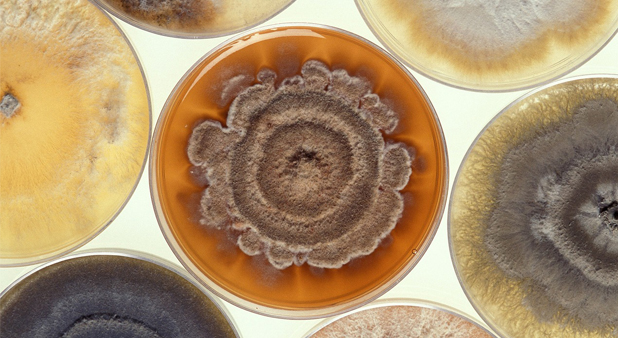Outdoors, molds play an important role in nature, helping break down and recycle dead organic matter, such as fallen trees. When they come indoors, however, problems may come with them. According to the Centers for Disease Control and Prevention (CDC), types of mold most commonly found inside include Aspergillus, Cladosporium, Penicillium, and Alternaria. Stachybotrys chartarum, or black mold, is a bit less common but far from rare. Here’s a bit about each of these fungi:
Aspergillus
There are about 200 varieties of this very common mold. Some of them can cause eye, nose, and throat irritation in some people. It can cause more serious infections in in people who have compromised immune systems. The term aspergillosis refers to illnesses linked to this type of mold.
The appearance of Aspergillus varies depending on the species. Aspergillus fumigatus, which is frequently found in kitchens and bathrooms, tends to be blue-green or gray and have a powdery texture. Aspergillus versicolor starts out white but changes to yellow, orange, or green as it matures, depending on the growth surface and conditions. It typically shows up in basements, bedding, and on wallboard materials. Aspergillus niger is a major component of mildew and often found growing on damp walls.
Cladosporium
There are over 700 species of mold within this genus. Colonies are olive-green to brown or black. Like other molds, species of this mold genus grow where there is moisture. It’s often found on the back of toilets or on painted surfaces. Large amounts of airborne species can severely affect people with asthma or respiratory diseases.
Penicillium
Typically green in color but sometimes blueish, Penicillium species can grow indoors even if relative humidity is low, as long as the surface it’s growing on has moisture. It’s been found on ceiling tiles, wallpaper, insulation, and mattresses, among other places. It generally prefers materials that have been damaged by water.
Alternaria
This genus includes 299 species of mold. They form thick colonies that can be green, black, or gray. Alternaria molds can contribute to allergic reactions such as hay fever or trigger asthma symptoms. Serious infections are rare, except in people who have compromised immune systems.
Stachybotrys chartarum
(also called Stachybotrys atra or black mold)
This slimy, greenish-black mold typically grows on material with high cellulose and low nitrogen content, such as wallboard and insulation. It is especially fond of materials that are damp or water-damaged. It requires a high moisture content to grow.
Black mold has been linked to irritation of the eyes, nose and throat. Additional, more serious symptoms, such as chronic fatigue and headaches, have been associated with it as well.
It isn’t always easy to identify exactly which type of mold you have, as mold can take many different forms. The same mold can develop different colors depending on where it’s growing. Check out this site that contains 100 pictures of indoor mold to see the variety.
Fortunately, pinning down the exact species of mold isn’t terribly important. Mold remediation processes are the same for most types of mold. The important thing is to determine if you have a mold problem of any kind, and if so, have it professionally dealt with.


